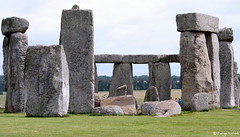Traduzione by PAOLO FRESU, volontario di English Gratis. Il testo originale è tratto da una pagina del sito inglese di Wikipedia ed è disponibile nel rispetto della licenza Creative Commons Attribution 2.5
![]() photo credit: Juergen Kurlvink
photo credit: Juergen Kurlvink

Stonehenge
Stonehenge is a prehistoric monument located in the English county of Wiltshire, about 3.2 kilometres (2.0 mi) west of Amesbury and 13 kilometres (8.1 mi) north of Salisbury.
Stonehenge è un monumento preistorico situato nella contea inglese di Wiltshire, a circa 3,2 kilometri (2 miglia) ad ovest di Amesbury e a 13 kilometri (8,1 miglia) a nord di Salisbury.
One of the most famous sites in the world, Stonehenge is composed of earthworks surrounding a circular setting of large standing stones and sits at the centre of the densest complex of Neolithic and Bronze Age monuments in England, including several hundred burial mounds.
Stonehenge, uno dei siti archeologici più famosi al mondo, è formato da un fossato che racchiude una struttura circolare fatta di enormi monoliti e si trova al centro del complesso di monumenti neolitici e dell’età del bronzo più consistente d’Inghilterra comprendente diverse centinaia di tumuli.
Archaeologists had believed that the iconic stone monument was erected around 2500 BC.
Gli archeologi avevano in un primo tempo creduto che Stonehenge fosse stato eretto intorno al 2500 a.C.
However, one recent theory has suggested that the first stones were not erected until 2400-2200 BC, whilst another suggests that bluestones may have been erected at the site as early as 3000 BC.
Invece, una recente teoria ha suggerito che le prime pietre non vi siano state collocate prima del 2400-2200 a.C., mentre un’altra teoria ipotizza che le doloriti (pietre di colore grigio blu) possano essere state erette nel sito addirittura prima del 3000 a.C.
>>> The surrounding circular earth bank and ditch, which constitute the earliest phase of the monument, have been dated to about 3100 BC.
Il terrapieno circolare e il fossato circostanti, che rappresentano la primissima fase del monumento, sono state datate all’incirca al 3100 a.C.
The site and its surroundings were added to the UNESCO’s list of World Heritage Sites in 1986 in a co-listing with Avebury henge monument, and it is also a legally protected Scheduled Ancient Monument.
Il sito e i suoi dintorni sono stati inseriti nel 1986, insieme ai monumenti megalitici di Avebury, nella lista dei siti Patrimonio dell’UNESCO, e sono, inoltre, legalmente tutelati dalla Scheduled Ancient Monument.
Stonehenge itself is owned by the Crown and managed by English Heritage while the surrounding land is owned by the National Trust.
La stessa Stonehenge appartiene alla Corona ed è amministrata dall’English Heritage; l’area circostante appartiene, invece, al National Trust.
New archaeological evidence found by the Stonehenge Riverside Project indicates that Stonehenge served as a burial ground from its earliest beginnings.
Nuove testimonianze archeologiche trovate dal Stonehenge Riverside Project suggeriscono che Stonehenge venisse utilizzato come cimitero sin dalle sue primissime origini.
The dating of cremated remains found that burials took place as early as 3000 B.C, when the first ditches were being built around the monument.
La datazione di resti di cremazioni dimostra che le sepolture avvenissero già dal 3000 a.C., quando si stavano costruendo i primi fossati attorno al monumento.
Burials continued at Stonehenge for at least another 500 years when the giant stones which mark the landmark were put up.
Le sepolture a Stonehenge continuarono per almeno altri 500 anni durante i quali vennero posizionati i megaliti che delimitano il monumento.
According to Professor Mike Parker Pearson, head of Stonehenge Riverside Project:
Secondo il professor Mike Parker Pearson, coordinatore del Stonehenge Riverside Project:
“Stonehenge was a place of burial from its beginning to its zenith in the mid third millennium B.C.
“Stonehenge è stato un posto di sepolture dalle sue origini sino al suo apice nella metà del terzo millennio a.C.
The cremation burial dating to Stonehenge’s sarsen stones phase is likely just one of many from this later period of the monument’s use and demonstrates that it was still very much a domain of the dead.”
L’attribuzione temporale della cremazione dei defunti alla fase delle pietre sarsen di Stonehenge è probabilmente giusto una delle tante testimonianze dell’utilizzo del monumento da questo successivo periodo e documenta, inoltre, molto bene come esso fosse proprio un sito per i defunti.”

